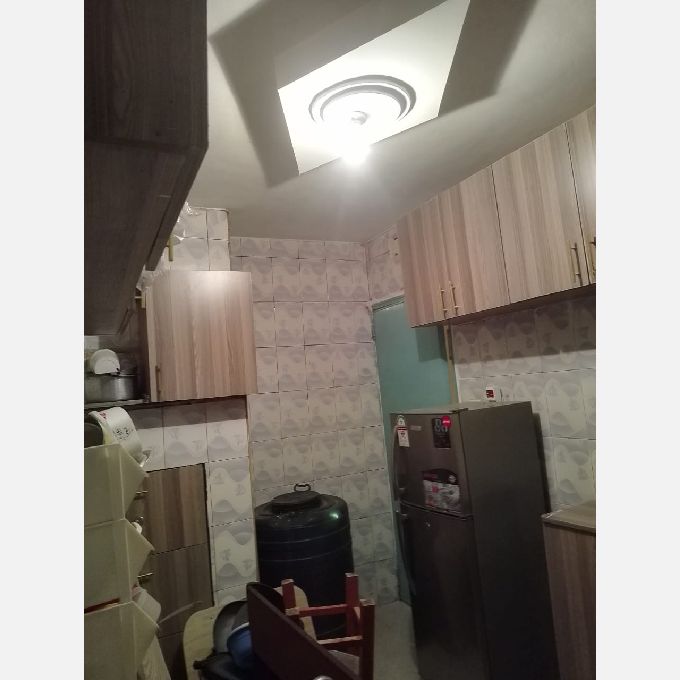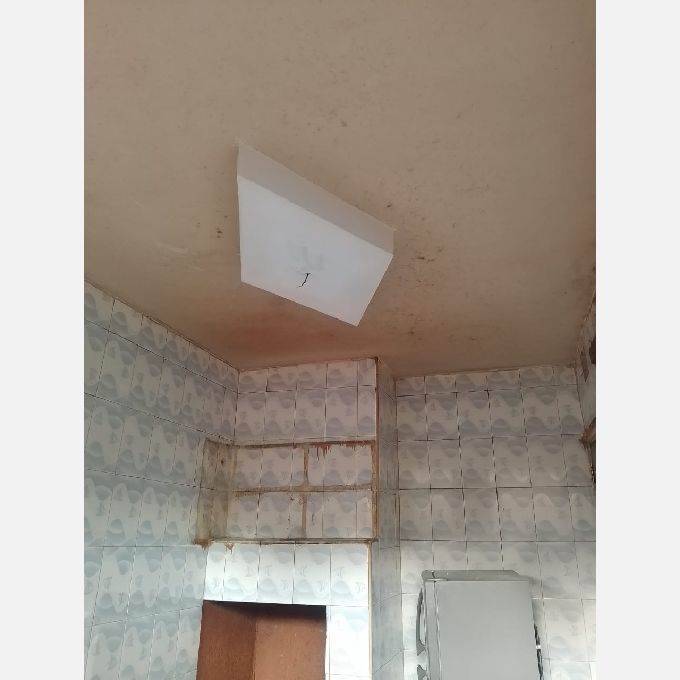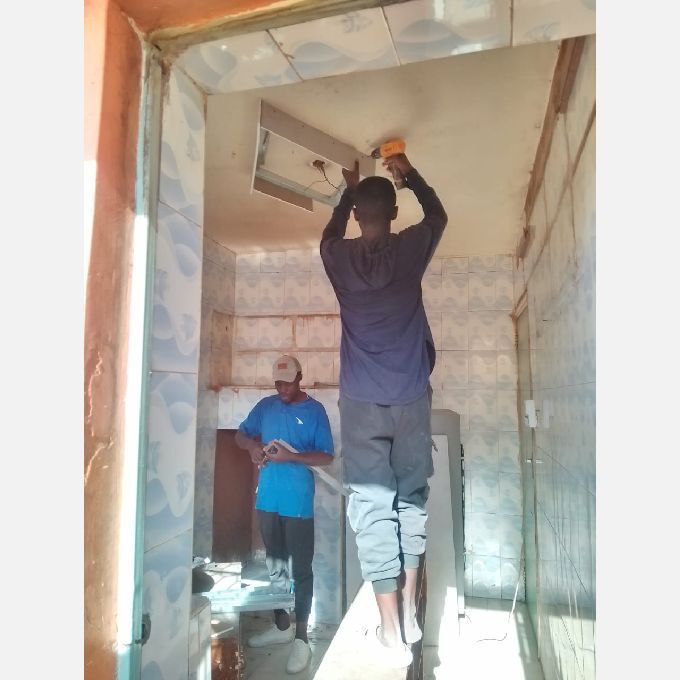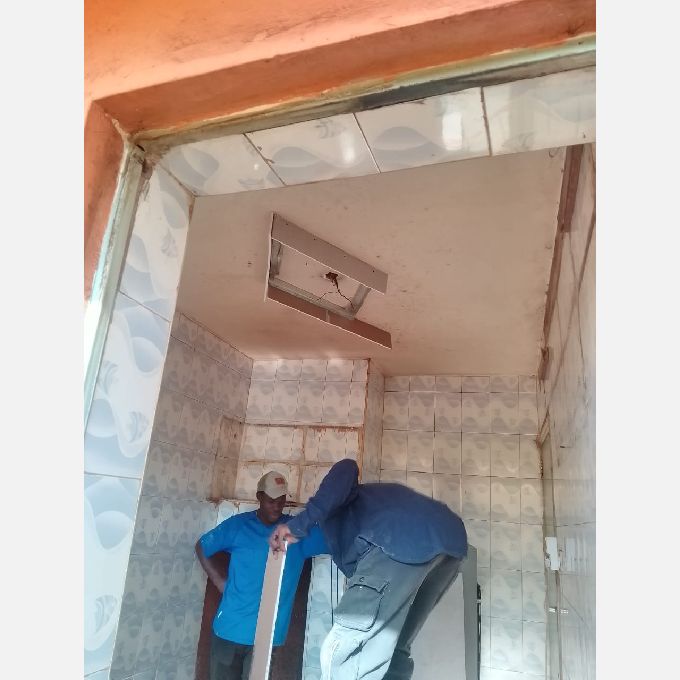A client in Nakuru recently reached out to us with a request to install a gypsum ceiling in their home kitchen. The goal was to enhance the overall aesthetic and functionality of the space, while maintaining a clean, modern, and durable finish. As experts in ceiling installations, we knew that gypsum was the perfect choice due to its flexibility, cost-effectiveness, and ability to add a sophisticated touch to any room.
We began by thoroughly assessing the kitchen's layout, size, and structural requirements to ensure a seamless installation. Our team provided a range of design options, and after discussions with the client, we selected a sleek, contemporary design that would complement the kitchen’s style. Special attention was given to the placement of light fixtures and ventilation systems, ensuring that the gypsum ceiling would not only be visually appealing but also practical.
The installation process was carried out with precision. Our skilled technicians ensured that the gypsum boards were perfectly aligned, securely fixed, and properly finished, creating a flawless surface. The client was kept informed throughout the process, with all concerns addressed promptly.
Upon completion, the results were outstanding. The new gypsum ceiling significantly transformed the kitchen, providing a bright, spacious feel while enhancing the overall ambiance of the home. The client was thoroughly impressed with the quality and professionalism of our work. We take pride in offering the best gypsum ceiling installations services that transform spaces, and the kitchen now serves as an inviting and stylish area for both cooking and socializing.
Benefits of Installing a Gypsum Ceiling in Your Kitchen
Gypsum ceilings offer multiple advantages, particularly in the kitchen, where they can elevate both function and style. Below are some key benefits:
- Aesthetic Appeal: Gypsum ceilings are sleek and offer a clean, polished look. They can be customized to suit various design preferences, whether you prefer a contemporary, minimalist design or a more traditional aesthetic. The smooth finish provides a seamless appearance, ideal for enhancing the visual appeal of your kitchen.
- Energy Efficiency: Gypsum boards can help improve energy efficiency in the kitchen. The material acts as an insulator, helping to regulate the temperature in the room by keeping it cooler during the summer and warmer during the winter. This can result in lower energy bills as your HVAC system works less to maintain a comfortable indoor temperature.
- Improved Sound Insulation: Gypsum ceiling panels offer soundproofing benefits, reducing the transmission of noise between rooms. In a kitchen, this feature can be especially valuable, as it dampens the sound of cooking appliances or conversations, creating a quieter, more pleasant environment.
- Moisture Resistance: Gypsum boards are ideal for humid environments like kitchens. They are designed to resist moisture, preventing the growth of mold and mildew. This is particularly important in kitchens, where water splashes and cooking steam are common.
- Fire Resistance: Gypsum is naturally fire-resistant. This safety feature makes it a popular choice for ceilings in spaces like kitchens, where fire hazards from cooking are a concern. By adding a gypsum ceiling, you can reduce the risks associated with accidental fires.
How Is Gypsum Ceiling Installed in a Home Kitchen?
Installing a gypsum ceiling in a kitchen requires precise steps and expertise to ensure a smooth and durable finish. At our company, we follow a systematic process to achieve optimal results. Here's a breakdown of how we install a gypsum ceiling in your kitchen:
- Initial Preparation and Measurements: Before any installation begins, we first assess the space to determine the exact dimensions of your kitchen. This helps us calculate the amount of gypsum board needed. We also inspect the kitchen to identify any existing issues like cracks or water damage that may need attention before proceeding. After preparing the area, we clear the kitchen of furniture and appliances to create a safe, open workspace.
- Setting Up the Framework: We begin by installing the structural framework that will support the gypsum boards. This framework typically consists of metal or wooden battens. First, we mark the desired ceiling height on the walls to ensure a consistent level across the entire room. We then secure the battens along the perimeter of the kitchen, aligning them to the ceiling joists for stability. This framework acts as the grid to which the gypsum boards will be fastened, and it must be both level and secure to ensure the ceiling’s integrity.
- Installing the Gypsum Boards: Once the framework is in place, the gypsum boards are ready to be installed. We carefully cut each gypsum board to the required size to fit your kitchen’s layout. Using a power drill, we securely attach each board to the framework, ensuring that the boards align perfectly. The edges of the boards are fitted together, leaving minimal gaps. We also pay special attention to the placement around fixtures like lights or exhaust fans, ensuring everything is properly aligned and installed without disruption.
- Joint Treatment and Smooth Finishing: After all the boards are securely attached, we focus on the joints between the boards. We apply joint compound to fill any gaps and smooth out the seams, ensuring a seamless finish. This process is crucial for achieving the polished, clean look that gypsum ceilings are known for. Once the joint compound has dried, we sand the surface to eliminate any imperfections, providing a smooth and flawless finish.
- Final Touches and Painting: The final step in our installation process is the finishing. After ensuring the joint compound is completely dry and sanded, we apply a coat of paint or a finish of your choice. This step enhances the aesthetic appeal of the ceiling and protects the gypsum surface from moisture or stains. We take great care to ensure the paint is applied evenly for a professional, high-quality result.
Throughout the entire process, our team ensures that every detail is handled with precision and care. We use high-quality materials, including moisture-resistant gypsum boards for kitchens, to guarantee a durable and long-lasting ceiling. Whether it’s a standard ceiling or a custom design, we provide expert installation to ensure your kitchen looks and functions beautifully.
How Long Does It Take to Install a Gypsum Ceiling in a Kitchen?
The time required for installing a gypsum ceiling depends on several factors, including the kitchen size, the complexity of the design, and the skill level of the installers. On average, gypsum ceiling installation can take anywhere from one to three days. For smaller kitchens with simple layouts, installation might take as little as one day. However, for larger kitchens or those with custom designs, the project may extend over two or three days to ensure everything is done to a high standard. The drying time for joint compounds and paint should also be factored into the overall project timeline. Hiring professional gypsum ceiling installers like us can help speed up the process, as experienced contractors are familiar with the best practices and have the right tools for the job. Moreover, they ensure the ceiling is securely installed, providing peace of mind regarding its durability and performance.
How to Properly Maintain and Care for Gypsum Ceilings
To ensure the longevity of your gypsum ceiling, regular maintenance is necessary. Here are a few tips to help maintain your ceiling:
- Regular Cleaning: Gypsum ceilings are relatively low-maintenance. Dust and cobwebs can accumulate over time, so cleaning them periodically with a soft cloth or vacuum with a brush attachment will keep them looking fresh. Avoid using harsh chemicals or abrasive cleaners that could damage the surface.
- Check for Moisture Damage: Although gypsum boards are moisture-resistant, prolonged exposure to excess moisture can cause the boards to degrade. Regularly inspect your ceiling for signs of water damage, such as discoloration or warping. If you notice any damage, it's important to address it promptly to avoid further deterioration.
- Repair Cracks: Over time, small cracks may develop in the gypsum ceiling. These can be easily repaired with joint compound and a touch-up of paint. Ensure that any cracks are addressed as soon as they appear to prevent more significant damage.
- Repainting: If the ceiling paint starts to fade or peel, it may need a fresh coat. Repainting your gypsum ceiling every few years will maintain its appearance and ensure the surface remains protected.
By following these maintenance tips, you can keep your gypsum ceiling in top condition for years, ensuring it continues to enhance your kitchen’s appeal.
Gypsum ceiling installation can significantly improve the look and functionality of your kitchen. Whether you're after a sleek and modern design or a more traditional finish, gypsum boards offer a variety of benefits, from energy efficiency to sound insulation. If you're considering a gypsum ceiling for your kitchen, contacting a professional installation company can help ensure the project is completed efficiently and to a high standard.









